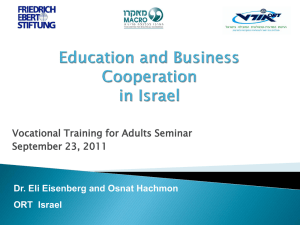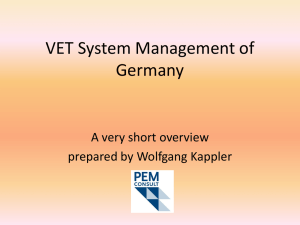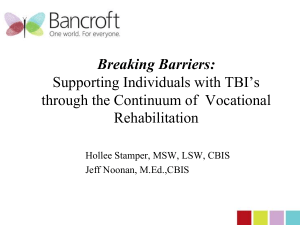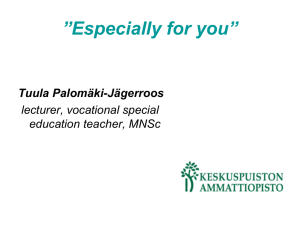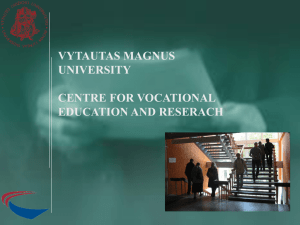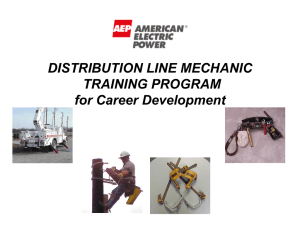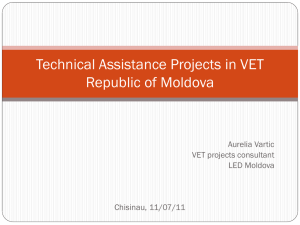VET IN MOLDOVA
advertisement
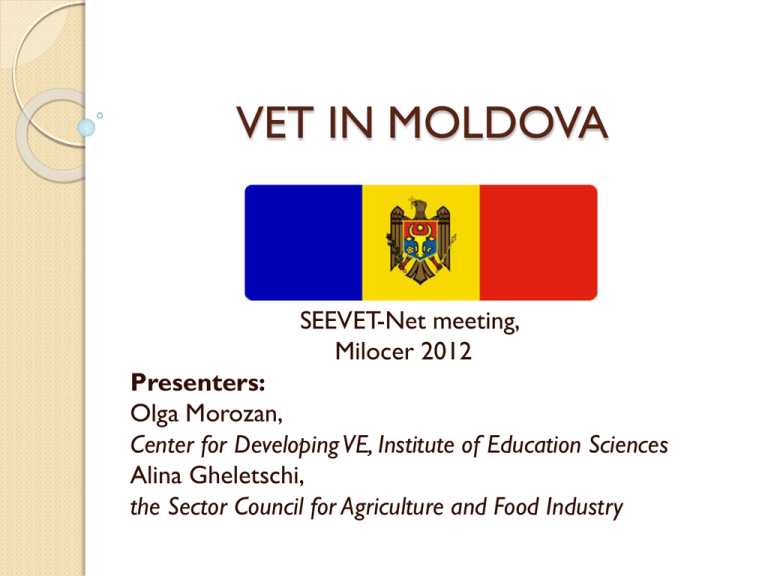
VET IN MOLDOVA SEEVET-Net meeting, Milocer 2012 Presenters: Olga Morozan, Center for Developing VE, Institute of Education Sciences Alina Gheletschi, the Sector Council for Agriculture and Food Industry The Republic of Moldova (general outlook) Is a landlocked state in Eastern Europe located between Romania to the west and the Ukraine to the north, east, and south. Capital: Chisinau The total area is 33,851 km². . Population: 3.5 million people The Republic of Moldova (general outlook) It is made of: • 32 districts, • 3 municipalities, • 2 autonomous regions (Gagauzia and Transnistria), • 65 cities (towns), • 917 communes, and • 699 small villages This makes for a total of 1,681 localities of Moldova, all but two of which are inhabited. Statistical data Cooperation with social partners in VET research Sector Councils Labour market ETF MINISTRY (supervisor) Center for Developing SVE At the internal level the Partnership in VET is realized among: Ministry of Education, 2) Center for Developing SVE, 3) vocational education institutions- 74 institutions: vocational schools-51, trade schools-15, prison trade schools-6, private institutions-2. 1) At the external level the Partnership in VET is realized among: Ministry of Education, Ministry of Labour, Social Protection and Family, National Agency of Labour Force Employment, Other Ministries such as Ministry of Agriculture and Food Industry and Ministry of Regional Development and Construction (with their subordinated specialty educational institutions –colleges) Entrepreneurs/patronates. WHY? To ensure a quality vocational educational process (initial and continuous) !!! How? Developing a coherent legal framework focused on strategic planning, Setting up the institutional mechanisms and process to consolidate the social partnership in vocational training; Consolidate the efficient negotiation capacities of economic actors regarding national and local requests, Offering real autonomy to vocational schools to improve the activity of training /preparing qualified workers, Ensuring continuity between initial vocational education and continuous vocational training. Review the qualification system, Module and unify the educational programs; Focusing vocational education on developing competences, Recognizing/certifying the vocational competences obtained through informal or non-formal way; Implementing the public-private partnerships; Optimization of the SVE school’s institutional network; Efficient use of institutional capacity by providing training courses. Legal Framework: Labour Code, 2003 ; Education Code, 1995; National Strategy “Education for Everybody”, 2004-2015. Government Decision nr..410 from 04.04.2003; The Concept of Secondary Vocational Education Development. Government Decision nr. 1334 from 3 December 2004, with approved modifications through Government Decision nr.992 from 13.08.2007; National Strategy on Labour Force Employment for 2007-2015; National Development Strategy “Moldova2020”; Newly developed normative documents: Recently approved “Methodology and Procedure of Developing and Reexamination of Occupational Standards (GD nr.952 from 16.12.2011)”. Draft of ‘Methodology of Validation of Vocational Competences Obtained through Informal and Non-formal Ways” (to be approved in October, 2012); Is being developed “Law on Occupations/Professions”!!! “Law on Occupations/Professions” will include the following parts: Chapter 1: General Provisions; Chapter II: Content Provisions. Qualification System. Chapter 3: Offering Qualification; Chapter 4: State Supervision; Chapter 5: Final and Transitory Provisions. Cooperation Mechanisms Active collaboration between Ministries of Labour, Social Protection and Family with the Ministry of Education, Sector Councils are constituted from representatives from Ministry of Education, Trade Unions, Economic Agents/”Patronates”; A representative from each Sector Council takes part in the Board of the Center for Developing Secondary Vocational Education, ETF offers work groups to develop policies /standards, etc. Economic Agents often collaborate with the vocational education institutions (take part in the Graduation Commission: a)3+2 where 3 means number of economic agents and 2 number of specialist teachers; b)organize practice in their factories or economic entities, paying salaries to students, etc.) Unfortunately not all regions have industry developed in their community => lack of economic agents. Experience of Social Partners in VET The Moldovan-Swiss Project SOMEC 2006-2009 with the following results: proposed 8 occupational standards projects, and Elaborated The National Council for Occupational Standards (GD nr.717 from 16.06.08). ETF within framework Mobility Partnership EU-RM 2009-2011: 5 occupational analyses were transformed into 5 occupational profiles (updated); 2 new occupational analyses are being developed ; As a result was elaborated The Methodology and Procedure of Developing and Reexamination of Occupational Standards (GD nr.952 from 16.12.2011) There were selected and established contacts, relationships with institutions, concerned people in the country and abroad. To analyze problems regarding the training process, collecting the proposals etc., there were organized multiple meetings and workshops with key target groups such as: 1. leaders of the Union Trade of Professional Education Institutions; 2. representatives of employers and Trade Union leaders from enterprises of the branches; -directors of Schools and Professional Schools of Trades; 3. prospective members of the Strategic Partnership for Vocational Training in both Agro-Industrial and Construction branches (at the central level); 4. the initiators to create the Partnership for Vocational Training (at the local level). To sum up: Achievements in the field of VET Sector Councils in collaboration with the Ministry of Education and the Ministry of Labour , Social Protection and Family developed important documents such as: Worked on strengthening the legislative framework: - Proposals to the draft Education Code; -The Methodology and Procedure of Developing and Reexamination of Occupational Standards; -The Validation and Certification of Learnt Lifelong Skills; -Pilot-projects for organization of Vocational Continuous Training. Obstacles Passivity of social partners; Only 2 existing Sector Council; Insufficient requirements of teams and financial sources/support; Sector Council isn’t a legal entity; The role of the Social Partners is often diminished; Lack of statistical date on Professional Continuous Training; Interest conflict. Challenges regarding further development of Social Partners in VET Active involvement of Social Partners; Creation of Sector Councils in all branches of economy; Organizing the Professional an Vocational Training in basis of the occupational standards; Creating the system of certification and validation of lifelong knowledge (Continuous Training).
